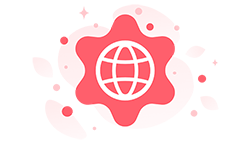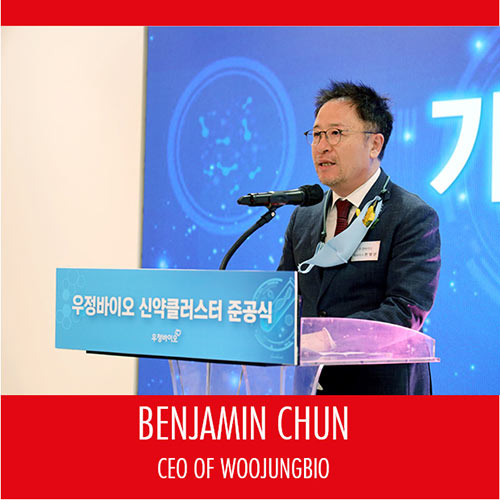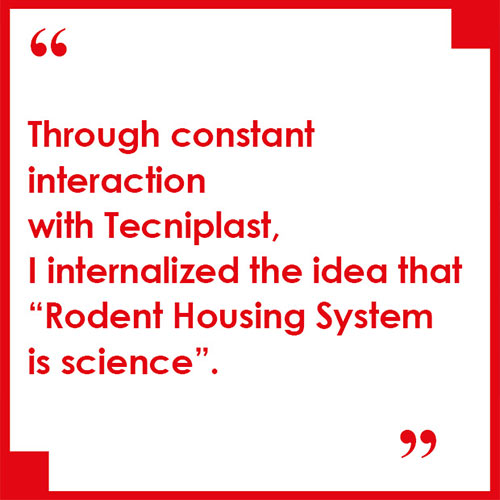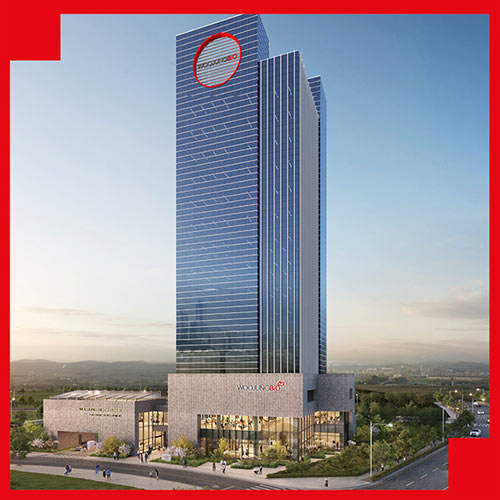
The current version of the Tecniplast website doesn't match your region. Please visit your local website to find information and offerings specific to your country.

The current version of the Tecniplast website doesn't match your region. Please visit your local website to find information and offerings specific to your country.

 The opening of WooJung's Biocluster in Dongtan, one of the most modern Lab Animal Facilities in the world
The opening of WooJung's Biocluster in Dongtan, one of the most modern Lab Animal Facilities in the world
Dear Benjamin Chun, we were completely blown away participating in the opening ceremony of your WoojungBio Cluster. Can you summarize the event?
The opening ceremony held for two consecutive days (September 30th –October 1st, 2021) was a momentous milestone in the history of biopharmaceutical development in Korea. Industry leaders and pioneers of new drug development participated and presented online/offline. At the 1st WoojungBio New Drug Cluster Inauguration Symposium, as CEO of WOOJUNGBio, I gave a presentation on ‘The role of a private cluster accelerating new drug development’, the President of Korea Development Fund gave one on ‘Strategic Globalization of K-New Drug Development’, and other 8 important topics were dealt with by RA, legal, VC experts. The messages were very interesting and informative, covering the methodology and roadmap of the future of domestic new drug development.
How did you arrive at the definition of this project? What was the magic which brought you the idea and led you on to define this fantastic project?
My first motivation goes back to the 1980s. Korea started new drug development from the 1980s under international trade pressure, and at that time, it was hard to develop new drugs given the scale of domestic R&D investment and no infrastructure.
With a mission to get over this difficult situation, we designed the policy proposal to the government: "There should be a public infrastructure for new drug development that can be shared by multiple pharmaceutical companies, without the need for them to build their own facilities, which are burdensome and unaffordable. Charles River's SPF animal for the first time in Korea, and entrusted most of Korea’s first new drug candidates to US and Japanese CROs. Based on this extensive experience, I gained insight into in-vivo preclinical trials and facilities, and as a result, developed a rough initial idea of building a new drug development cluster.

More importantly, I was able to materialize my initial idea, thanks to a close and long lasting relationship with Tecniplast Group (TP). Through constant interaction with TP, I internalized the idea that "Rodent Housing System is science".
The housing environment is the foremost determinant which can easily impact and even distort the data, regardless of the quality of lab animals.
Also, TP has been my mentor and good partner throughout my business journey. I was able to learn and gain a lot of information regarding the construction of cutting-edge vivarium in the life science field through the annual International Sales and Marketing Meeting (ISMM) which took place in Italy. Likewise, through decades of experience, I gained entrepreneurial insight and that's how I started the WOOJUNGBio Cluster for New Drug Development (WBNDC) project.
My future goal/aim for this project is to evolve WBNDC into a smart bio cluster business as a privately-led new drug development consortium. Entities such as start-up companies, individuals, pre-clinical experts, IP or contract experts, and large biopharmaceutical companies will gather around WBNDC’s top-notch analytical equipment and market-leading laboratory environment. They will freely interact, and share ideas, forming a cooperative and lively ecosystem. Also, with the help of consultations from investment and M&A experts, start-ups and individuals with creative ideas will be provided with technical evaluation reports leading to accurate investment decisions and domestic/foreign technology transactions. In essence, WBNDC will provide a one-stop service to drug developers and will build a playground and marketplace for so-called new drug development experts.
We have seen a strong increase in the demand for ISO systems due to the Covid Pandemic. Do you think that the research at WW level will increase biocontainment investments in the coming years after years of flat trends?
To start with, biocontainment investments will increase over the next few years. The Covid pandemic will revolutionize the direction of science and industry. Although the outbreak itself will ameliorate sooner or later. However, in light of the event, laypeople’s notion about personal hygiene and well-being has changed dramatically, and the development of various vaccines and therapeutics will continue accordingly. Considering this outlook, WoojungBio has a market-leading facility filled with TP/IWT ISO N system.
 In the future, government regulations and industry standards for bio-containment required for pathogen research will become more stringent. Thus, I think investments for advanced ISO systems should consider the robot and/or automated system to protect researchers/experimenters and prevent external leakages. As TP is located both in Europe and America, I believe TP can leverage the opportunity through interactive communications and shared knowledge worldwide, and I look forward to seeing how TP map out its business in the near future. Considering the increasing need for germ-free facilities for emerging microbiome research, WoojungBio also has germ-free facilities filled with Tecniplast's ISO P system.
In the future, government regulations and industry standards for bio-containment required for pathogen research will become more stringent. Thus, I think investments for advanced ISO systems should consider the robot and/or automated system to protect researchers/experimenters and prevent external leakages. As TP is located both in Europe and America, I believe TP can leverage the opportunity through interactive communications and shared knowledge worldwide, and I look forward to seeing how TP map out its business in the near future. Considering the increasing need for germ-free facilities for emerging microbiome research, WoojungBio also has germ-free facilities filled with Tecniplast's ISO P system.
Automation systems are not so common in LAS facilities, mainly for the costs and for the complexity. Can you tell us what determined you to choose our automation system?
The reason we decided on the automation system was my mission to operate the world's best Lab Animal System (LAS). Automated systems are employed to minimize human error and enable cleaning validation. In addition, I built an Automated Library Rack system to maximize space utilization.
The complexity of the automation system usage will disappear as users get used to it, just as we get used to new technology devices.
The ROI analysis until now is based on the information provided by Tecniplast. I trusted TP’s ROI analysis methodology as a Business Administration PhD. As we apply for the automated system, we will be able to accumulate real data, and thus, a more realistic analysis will be possible in the near future.
Another outstandingly important factor in choosing the automation system is the protection of the workers/experimenters and the environmental protection of the facility.
GUGLIELMO VISMARA - REGIONAL MANAGER ASIA-PACIFIC - TECNIPLAST S.P.A.